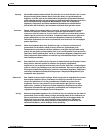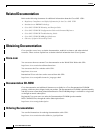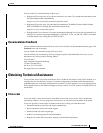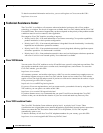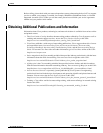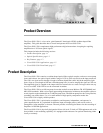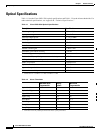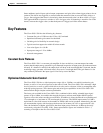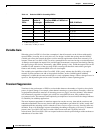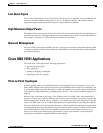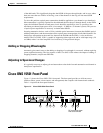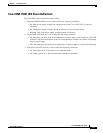
1-3
Cisco ONS 15501 User Guide
78-14134-02, Release 2.0
Chapter 1 Product Overview
Key Features
Some attributes (optical input, optical output, temperature and gain) allow alarm trigger points to be set
on them. The alarms are triggered, or asserted when the measured value crosses the value of Mean
±
Trigger. Once triggered the alarm is cleared only when the measured value is at Mean
±
90% of Trigger.
This approach builds a hysteresis window of 10% of trigger value. If chattering is noted for one of the
alarms, increase the trigger value (so that the hysteresis is bigger) to kill the alarm chatter.
Key Features
The Cisco ONS 15501 has the following key features:
• Constant flat gain of 17dB over the 1530 to 1563 nm band
• Optimized automatic gain control for the MAN
• Variable gain for flexibility in network design
• Typical transient suppression within 50 microseconds
• Low noise figure of < 6.0 dB
• Input power range of -29 to 0 dBm
• Network management
Constant Gain Flatness
The Cisco ONS 15501 is a constant gain amplifier. It does not deliver a constant output, but rather
ensures that the output energy spectrum is gain-flattened irrespective of input power (up to the maximum
allowed). If a channel is removed, the output level will drop at the wavelength that is removed, but the
remaining energy spectrum will remain nearly flat over its wavelength band. The gain flatness is also
only minimally affected if the input signal is not flat by several decibels.
Optimized Automatic Gain Control
The Cisco ONS 15501 has a wide input power range of 0 to -29 dBm, over which it maintains gain
flatness as well as a low noise figure across the entire C band. The Cisco ONS 15501 maintains a high
level of precision, as well as speed, which allows it to be used as a booster, inline or preamplifier, thus
reducing sparing expenses. The constant gain and noise figure capabilities of the Cisco ONS 15501
make network designs simpler and more predictable.
The lower gain available in the Cisco ONS 15501, combined with its ability to handle input signal
powers of up to 0 dBm, also enables the network designer to achieve much higher OSNR (optical
signal-to-noise ratio) after cascading several EDFAs. In addition, it allows the network to expand beyond
32 wavelengths to a maximum of 128 wavelengths if necessary. The OSNR improvements of 6 dB is
equivalent to a four-fold increase in the number of EDFAs that can be cascaded. Alternatively, the unit
can accommodate signals with four times the data rate (for instance, OC-192 as opposed to OC-48).
Thus, the limitations of higher gain EDFAs that have input powers limited to -6 dBm can be easily
overcome by using the Cisco ONS 15501. Some representative figures are included in Table 1-3,
assuming a flat input to the first Cisco ONS 15501.



